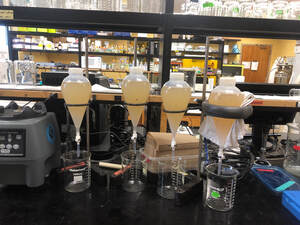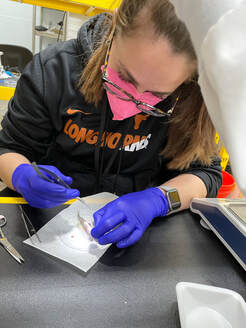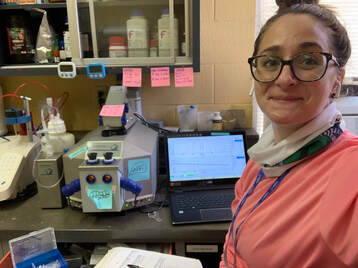Current Research
I have been a Postdoctoral Fellow at the University of Texas at Austin Marine Science Institute (UT MSI) since June 2018. In June 2023, I transitioned to a Research Scientist position at UT MSI. My research has focused on the impacts of environmental stressors and toxicants on fish physiology and development.
Toxicology
Deepwater Horizon Oil Spill

I worked as part of the RECOVER (Relationships of Effects of Cardiac Outcomes in fish for Validation of Ecological Risk) research team to determine the effects of the Deepwater Horizon oil spill on fishes of the Gulf of Mexico. My work within the team in Andrew Esbaugh's research lab focused on the combined impacts of hypoxia, temperature, and crude oil on the physiology of red drum (Scianops ocellatus).
Aerobic scope, the difference between an animal’s basal metabolic requirements and their maximum metabolic capacity, is considered to be a particularly important metric influencing ecological success in fishes. Crude oil exposure has been shown to impair cardiorespiratory function in fishes, which consequently reduces maximum metabolic rate, aerobic scope, and likely impairs ecological performance. Yet, oil exposure is not the only environmental stressor that can affect aerobic scope, especially in areas affected by crude oil spills (e.g. the Gulf of Mexico). Hypoxia (low dissolved oxygen) is known to constrain maximum metabolic rate in fishes, while high temperature raises basal metabolism and constrains maximum metabolic rate. Despite this knowledge, there has been little effort to explore how these environmental factors may influence the magnitude of metabolic injury following oil exposure. Therefore, the goal of my work was to investigate the effects of acute oil exposure, hypoxia, and temperature on the metabolic performance of an economically important fish common to the Gulf of Mexico – red drum.
Aerobic scope, the difference between an animal’s basal metabolic requirements and their maximum metabolic capacity, is considered to be a particularly important metric influencing ecological success in fishes. Crude oil exposure has been shown to impair cardiorespiratory function in fishes, which consequently reduces maximum metabolic rate, aerobic scope, and likely impairs ecological performance. Yet, oil exposure is not the only environmental stressor that can affect aerobic scope, especially in areas affected by crude oil spills (e.g. the Gulf of Mexico). Hypoxia (low dissolved oxygen) is known to constrain maximum metabolic rate in fishes, while high temperature raises basal metabolism and constrains maximum metabolic rate. Despite this knowledge, there has been little effort to explore how these environmental factors may influence the magnitude of metabolic injury following oil exposure. Therefore, the goal of my work was to investigate the effects of acute oil exposure, hypoxia, and temperature on the metabolic performance of an economically important fish common to the Gulf of Mexico – red drum.
Tire Wear Particles & 6PPD-quinone

I am part of a collaborative team at UT MSI investigating the impacts of tire wear particles and 6PPD-quinone on fishes within estuaries of the Coastal Bend of Texas. This work is funded by a grant to Dr. Kristin Nielsen through the Matagorda Bay Mitigation Trust.
Annual large-scale fish kills after storms are a serious issue for salmon populations migrating through highly urbanized watersheds in the Pacific Northwest region of the United States. Recently, these mass die-offs were linked to tire wear particles (TWPs) left on roadways, which are washed into nearby surface waters with stormwater runoff. The lethality of these TWPs have been attributed to 6PPD-quinone (a quinone byproduct of the ubiquitous tire antiozonant 6PPD), which has a median lethal concentration of < 1-µg/L for select species of salmonids. However, there remains a paucity of data describing the differential toxicity of this compound across species and ontogenies, or its sub-lethal effects during early life stages. Additionally, no toxicity values have been developed for estuarine fish species exposed to 6PPD-quinone. Filling this data gap is particularly significant because estuaries receiving inflows from highly urbanized watersheds are especially vulnerable to TWPs. To close these data gaps, I determined the toxicity of 6PPD-quinone to both model (e.g., sheepshead minnow [Cyprinodon variegatus]) and non-model (red drum [Sciaenops ocellatus], southern flounder [Paralichthys lethostigma]) estuarine fishes; examined the relative sensitivities of early life stages within a single species; and derived sub-lethal toxicity values for early life stage fish. Results indicate that the toxicity of 6PPD-quinone varies demonstrably across species and ontogeny, with toxicity values spanning several orders of magnitude in some species. These data are a significant contribution towards advancing our knowledge of this newly identified and likely pervasive environmental toxicant.
Annual large-scale fish kills after storms are a serious issue for salmon populations migrating through highly urbanized watersheds in the Pacific Northwest region of the United States. Recently, these mass die-offs were linked to tire wear particles (TWPs) left on roadways, which are washed into nearby surface waters with stormwater runoff. The lethality of these TWPs have been attributed to 6PPD-quinone (a quinone byproduct of the ubiquitous tire antiozonant 6PPD), which has a median lethal concentration of < 1-µg/L for select species of salmonids. However, there remains a paucity of data describing the differential toxicity of this compound across species and ontogenies, or its sub-lethal effects during early life stages. Additionally, no toxicity values have been developed for estuarine fish species exposed to 6PPD-quinone. Filling this data gap is particularly significant because estuaries receiving inflows from highly urbanized watersheds are especially vulnerable to TWPs. To close these data gaps, I determined the toxicity of 6PPD-quinone to both model (e.g., sheepshead minnow [Cyprinodon variegatus]) and non-model (red drum [Sciaenops ocellatus], southern flounder [Paralichthys lethostigma]) estuarine fishes; examined the relative sensitivities of early life stages within a single species; and derived sub-lethal toxicity values for early life stage fish. Results indicate that the toxicity of 6PPD-quinone varies demonstrably across species and ontogeny, with toxicity values spanning several orders of magnitude in some species. These data are a significant contribution towards advancing our knowledge of this newly identified and likely pervasive environmental toxicant.
Per- and Polyfluoroalkyl Substances (PFAS)
I have worked in collaboration with Kathleen Roark (PhD Student, UT MSI) in Dr. Kristin Nielsen's lab to determine the impacts of both long- and short-chain PFAS on the survival and development of early life stage red drum and southern flounder. This work is currently on-going, and Kristin Nielsen (PI) and I (co-PI) recently received funding to study the impacts of PFOA and other PFAS on locally important fishes in estuaries in South Texas.
Anti-Diabetics
I have had the opportunity to work as part of a collaborative group in Dr. Kristin Nielsen's lab investigating the impacts of metformin and guanylurea on the survival, development, and physiology of red drum, southern flounder, and fathead minnows (Pimephales promelas). We are also investigating the impacts of semaglutide (Ozempic™) and tirzepatide (Mounjaro™) on red drum development.
Physiology
Mitochondrial plasticity under hypoxia

I worked on a collaborative team with Dr. Angelina Dichiera and Dr. Benjamin Negrete Jr. in Dr. Andrew Esbaugh's lab to determine the impacts of hypoxia acclimation on the physiology of red drum. This work was supported by a National Science Foundation Grant awarded to Dr. Andrew Esbaugh.
Hypoxia (low dissolved oxygen), a pervasive stressor in aquatic environments, is a significant threat facing fishes. As animals require oxygen to produce ATP, hypoxia can significantly limit aerobic capacity in fishes. However, some fishes show respiratory flexibility that rescues aerobic performance, including plasticity in mitochondrial performance. This plasticity may result in increased mitochondrial efficiency (e.g., less proton leak), increased oxygen storage capacity, and higher citrate synthase activity under hypoxia. To test this, I acclimated red drum to 8-days of chronic hypoxia to induce a hypoxic phenotype. Fish were terminally sampled for cardiac and red muscle tissue, which was immediately dissected, gently homogenized, and placed in an Oxygraph 2K high resolution mitochondrial respirometer. A standard multiple-substrate-uncoupler-inhibitor titration protocol was used to quantify oxidative phosphorylation, proton leak, and maximum respiration in both hypoxia-acclimated and control fish. Tissue was also collected to assess mitochondrial plasticity through citrate synthase activity and gene expression for oxygen storage.
Hypoxia (low dissolved oxygen), a pervasive stressor in aquatic environments, is a significant threat facing fishes. As animals require oxygen to produce ATP, hypoxia can significantly limit aerobic capacity in fishes. However, some fishes show respiratory flexibility that rescues aerobic performance, including plasticity in mitochondrial performance. This plasticity may result in increased mitochondrial efficiency (e.g., less proton leak), increased oxygen storage capacity, and higher citrate synthase activity under hypoxia. To test this, I acclimated red drum to 8-days of chronic hypoxia to induce a hypoxic phenotype. Fish were terminally sampled for cardiac and red muscle tissue, which was immediately dissected, gently homogenized, and placed in an Oxygraph 2K high resolution mitochondrial respirometer. A standard multiple-substrate-uncoupler-inhibitor titration protocol was used to quantify oxidative phosphorylation, proton leak, and maximum respiration in both hypoxia-acclimated and control fish. Tissue was also collected to assess mitochondrial plasticity through citrate synthase activity and gene expression for oxygen storage.
